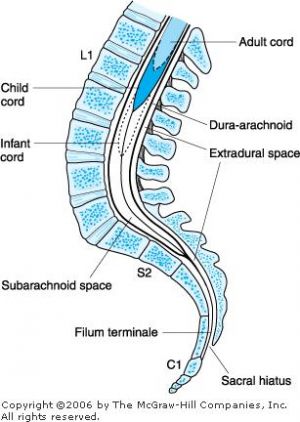TYK5
When attempting a spinal or epidural neuroaxial technique, it is imperative to know the anatomy differences of the pediatric population. The spinal cord of neonates extends to which of the following levels?
A. T10 vertebra
B. T12 vertebra
C. L3 vertebra
D. L5 vertebra
E. S1 vertebra
Answer

The answer is C. There are many anatomical differences in the pediatric population. One difference is the relationship of the spinal column in relation to the vertebral bodies when compared to the adults. This fact is even more complicated in that the position of the caudal end of the spinal cord varies with age in relationship to the vertebral bodies even in the pediatric population. The spinal cord of neonates can extend as far caudad as the level of the L3 vertebral body. Care must be taken with spinal or epidural injections in this area as the spinal cord may extend lower (more caudal) than the adult counterpart. Also, this is why many lumbar punctures in infancy are done in the low L4/L5 interspace to avoid, or at least minimize, the possibility of spinal cord trauma. [1][2]